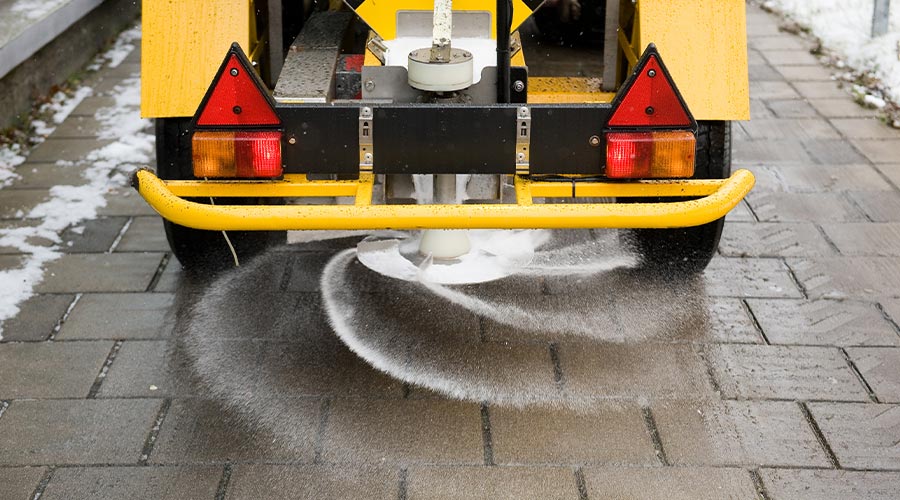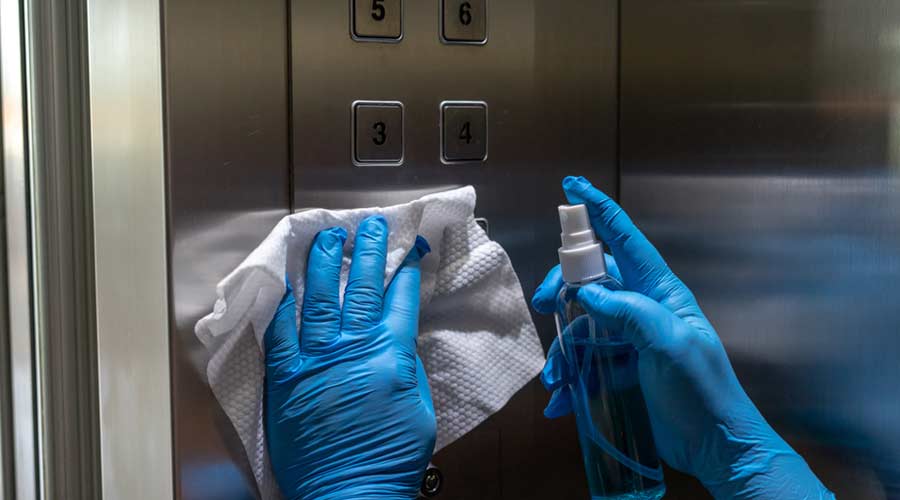
Distributors who capitalize on strong partnerships with their end user customers will assist with product application as well — which is important because deicing products are often overused. If used incorrectly or in excess, ice melting products can cause damage to concrete, buildings, landscaping, and even indoor floors.
“People don’t understand that they’re literally wrecking their buildings,” says Craddock. “The salt gets tracked inside, destroys floors and carpets, kills grass, rots concrete, and if you pile it against the building, can even cause foundation damage.”
Robert Bowers, vice president of engineering for the Concrete Masonry and Hardscapes Association, Herndon, Virigina, advises following dosage rate guidelines with every application. Too much product, he says, will impact the surface’s freeze-thaw durability and deteriorate the concrete.
Craddock also recommends smarter strategies, including specifying earth-friendly alternatives such as magnesium chloride or calcium magnesium acetate.
“Magnesium products often have colorants — usually blue or pink — so if you see color, you know there’s enough on the ground,” he explains. “They’re also shaped like little pellets that crush under your feet like eggshells, which is safer than rock salt. With rock salt, building occupants can slip on the crystals if there’s too much.”
No matter which ice melt product is used, the application should include documentation. Maintaining proper records of products used and dates and times of application can protect against liability issues arising from events like slip-and-fall cases.
Making sure customers have products and procedures in place prior to a storm is essential. But each storm is unique and a uniform response can lead to chaos, wasted resources, and hazardous conditions. Distributors should recommend their customers get storm advice from meteorological sources or private forecasting services, not the people on television.
Knowing what type of precipitation is coming — and what’s going on underneath it — is also critical. It’s important to know both the temperature of the air and the pavement. Those two numbers are generally not going to be the same. Arthofer recommends distributors supply a handheld reader to check pavement temperatures. These can be mounted to vehicle side mirrors for live feedback as customers clear snow.
Arthofer also stresses that snow and ice management requires effective education. However, the industry veteran who works with the American Public Works Association (APWA) and SIMA admits it can be challenging to reach contractors and municipalities who are too busy, too set in their ways, or too unaware to seek out better solutions.
Many distributors offer their own training and education, but for those that don’t, encouraging attendance at events like the SIMA Symposium or other educational opportunities can be helpful. There are a range of resources available to improve the skill set of the entire industry.
Of course, distributors also have an opportunity to educate every time they interact with their customers.
“When someone calls to order salt, we say, ‘Hey, have you ever considered treated salt? Did you know there’s actually a difference?’ Or ‘Have you ever done liquids?’ Most of the time they say, ‘No, it costs too much.’ But what if we take that major cost out of the equation? You don’t have to buy all the equipment; you just need a sprayer. We’ll supply everything else,” says Arthofer.
This solution-focused approach led to one of Arthofer’s most innovative projects: a 24/7 liquid brine filling station in the Twin Cities.
“I worked with a snow truck manufacturer to design a system where guys can pull up anytime, hook up their hose, punch in a PIN, and get whatever blend they want. It’s fast, easy, and it removes the barriers,” he says.
When providing ice melt education (and making sales), distributors should not overlook southern states. As erratic weather patterns rewrite the winter rules, warm-weather states are facing winter events they’re not equipped to handle.
“If weather patterns stay the way they are, they’re going to have to look at that,” says Arthofer, noting that the simplest and easiest strategy is to keep liquids on hand. “It doesn’t take a lot of area to store brine. Just a tank, really.”
Finishing Touches
As more contractors and municipalities expand their winter arsenals with brines, treated salt, and traditional rock salt, proper storage is increasingly important.
“Though these products do not spoil, if they get moisture in them, they will start to clump together and become less effective,” Craddock says. “You need to make sure customers know how to store them properly.”
Some customers use shipping containers for simple, weatherproof, and portable storage, while others opt for small hoop buildings, which offer an affordable, scalable option for bulk material storage. However, not every client can store products on-site.
“A lot of places won’t let you store product on their property, so you need to have your own yard or hub,” says Arthofer. “Whether it’s a shop or just some extra real estate, having a centralized salt hub can really streamline operations.”
After months of snow, ice, and heavy product use, hardscapes deserve a little TLC, and it’s vital that distributors remind their customers about that, Bowers adds. He recommends removing excess salt or sand that’s built up over the season, which will prevent long-term surface damage.
“Excess sand acts like sandpaper underfoot and under tires — accelerating wear and tear through abrasion,” he says. “The same goes for residual salt, which can continue corroding surfaces and leaching into surrounding soil if not cleaned up properly.”
Ronnie Wendt is a freelance writer and owner of In Good Company Communicationsin Waukesha, Wisconsin.
Knowing What Ice Melt to Buy and When

 Celebrating BSCAI's 60th Anniversary eBook
Celebrating BSCAI's 60th Anniversary eBook The Down and Dirty on Cleaning in Virus Season
The Down and Dirty on Cleaning in Virus Season How Surfactant Use is Expanding in Commercial Cleaning
How Surfactant Use is Expanding in Commercial Cleaning